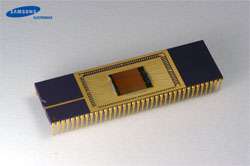Industry's First 60-Nanometer 8-Gigabit NAND Flash Memory

Samsung Electronics Co., Ltd., the leader in advanced semiconductor technology, announced today that it has developed the industry's first 60-nanometer (nm) 8-Gigabit (Gb) NAND Flash memory device for data storage medium such as low density mobile hard disks for mobile appliances.
"NAND flash technology development continues to double density growth on an average of every 12 months," said Dr. Chang Gyu Hwang, president and CEO of Samsung Electronics' Semiconductor business. Verifying the New Memory Growth Model he first presented at the ISSCC's 2001conference, Dr. Hwang said the industry has seen densities grow from 256 Megabit (Mb) in 1999, to 512Mb in 2000, 1Gb in 2001, 2Gb in 2002, 4Gb in 2003 and now 8Gb in 2004"
Samsung's advanced 60nm process technology is two thousandths the width of a piece of human hair, and achieves approximately 30 percent reduction in cell size over the 70nm 4Gb NAND Flash memory developed last year. The result is the world's smallest 0.0082µm2 per bit cell size.
The key to development at such high densities and fine circuitry design is a 3-D cell transistor structure and high-dielectric gate insulating technology that minimizes the interference level between cells. In addition, by utilizing the most widely used KrF lithography technology bit cost is reduced by 50 percent.
Samsung is further enhancing its technology base by introducing its new multi level cell (MLC) technology in the 60nm process technology. The new 8Gb MLC NAND flash memory broadens the company's flash memory portfolio, meeting increasing market demand for efficient and cost effective non volatile storage devices. MLC technology also offers designers a competitive choice for low power, small form factor storage solutions that enable low density mobile internal hard disks (HDD) for compact mobile applications.
The 8Gb NAND flash memory will allow designs of up to 16Gigabytes (GB) of storage on a single memory card. That 16GBs of memory translates into storage of up to 16 hours of DVD quality video or 4,000 (five minutes per song) MP3 audio files.
According to market research firm iSuppli, the NAND flash market has doubled annually in volume from $900 million in 2001 to $4.2 billion in 2003. iSuppli expects NAND sales to reach $7.2 billion this year and $9.9 billion in 2005. This contrasts the growth of NOR flash sales, which shows a three percent CAGR and sales expanding from $6.7 billion in 2001 to a forecasted $7.6 billion in 2005.
In line with these market trends, Samsung's NAND flash business has shown strong growth expanding from $400 million in 2001 to $2.1 billion in 2003. The company is focused on accelerating production of advanced devices with 2Gb NAND flash production shipping over 10 million pieces per month to date in 2004. Samsung expects to launch mass production of the 4Gb NAND flash by the first quarter of 2005. This year Samsung expects to double volume of NAND sales and account for 65 percent global market share.

















